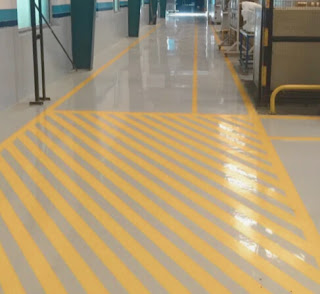Epoxy Flooring Explained: Types, Benefits, and Costs
Epoxy flooring is a tough, long-lasting surface that’s created by combining a resin with a hardener. When mixed together, these two components form a rigid plastic-like coating that adheres strongly to concrete surfaces. This flooring solution is used in both residential and commercial spaces thanks to its durability, resistance to wear, and sleek finish.
This guide breaks down the different types of epoxy flooring and the benefits they offer across various environments.
1. What Is Epoxy Flooring?
Epoxy flooring is a protective and decorative coating applied over concrete floors to increase strength, resistance, and visual appeal. It cures to form a hard, glossy surface that is seamless and easy to clean. Commonly found in garages, warehouses, showrooms, hospitals, and kitchens, epoxy is known for its ability to withstand heavy traffic, spills, and harsh conditions.
Unlike paint, epoxy chemically bonds with the concrete, creating a long-lasting layer that does not peel or crack easily when properly installed.
2. Types of Epoxy Flooring
There are several epoxy systems designed to meet specific needs. Here's a breakdown of the most popular types:
• Self-Leveling Epoxy
Perfect for uneven or cracked surfaces, this type spreads evenly across the floor to form a smooth, seamless surface. It is often used in commercial buildings, garages, and residential basements.
• Mortar Epoxy
The most durable option, this type combines epoxy resin with quartz sand or graded aggregates. It’s ideal for industrial environments where floors face heavy loads and mechanical impact.
• Quartz-Filled Epoxy
A combination of epoxy resin and coloured quartz granules, this type is decorative and functional. It provides a slip-resistant finish and is widely used in restrooms, cafeterias, schools, and commercial kitchens.
• Epoxy Flake Flooring
Flake systems include coloured chips or flakes added to the epoxy base layer. They offer texture, visual interest, and additional grip. Ideal for garages, showrooms, and recreational spaces.
• Anti-Static Epoxy
Designed for environments where electrostatic discharge must be controlled, such as laboratories, electronics manufacturing, and data centres. This type safely dissipates static charges from the environment.
• Metallic Epoxy
This decorative system features metallic pigments mixed into the epoxy. It produces a marbled, three-dimensional appearance and is commonly used in lobbies, salons, and high-end residential interiors.
• Vapor Barrier Epoxy
Used primarily on concrete with high moisture content, this epoxy prevents vapour from seeping through the surface. It’s an effective base layer for additional flooring or coatings.
3. Key Benefits of Epoxy Flooring
Epoxy flooring offers several functional and aesthetic advantages across both residential and commercial settings.
a) High Durability
Epoxy forms a strong, impact-resistant surface that can endure heavy foot traffic, machinery, and dropped tools. It’s commonly used in industrial settings for this reason, but it’s equally effective in garages and utility spaces.
b) Low Maintenance
Epoxy floors are seamless and non-porous, making them resistant to stains, dust, and spills. Routine cleaning typically involves sweeping and occasional mopping—no special treatments are needed.
c) Chemical and Water Resistance
This flooring stands up well to oil, gasoline, bleach, and cleaning products, which makes it an excellent choice for auto shops, labs, and kitchens. It also resists moisture, preventing mould or mildew growth beneath the surface.
d) Visual Appeal
With a high-gloss finish, epoxy flooring enhances the brightness and cleanliness of any space. Colour options, flakes, patterns, and metallic designs offer plenty of ways to match the look of your interiors or branding.
e) Customisation
Whether you want company logos, directional markers, or decorative effects, epoxy can be fully tailored. This makes it ideal for commercial spaces that want to stand out or reinforce their brand identity.
f) Safety Options
Non-slip additives can be mixed into the epoxy to improve traction in wet or high-traffic areas. Anti-static options further improve safety in sensitive workspaces like labs and server rooms.
g) Environmentally Friendly
By coating existing concrete floors instead of replacing them, epoxy reduces material waste. Its long lifespan also means fewer repairs and replacements over time.
h) Quick Application
Professional epoxy floor systems cure quickly, often allowing spaces to be used again within a few days. This makes them an efficient choice for businesses or homes that can’t afford long downtimes.
4. Things to Consider Before Choosing Epoxy
While epoxy flooring has many advantages, it’s important to consider certain factors before installation:
-
Surface Preparation is Crucial: Concrete must be clean, dry, and free of cracks or contaminants for epoxy to adhere properly.
-
Slipperiness: Glossy epoxy can be slick when wet, so choose a textured finish for areas prone to moisture.
-
Installation Requires Precision: Poor installation can lead to bubbling, peeling, or an uneven surface. For best results, hire an experienced professional.
-
UV Sensitivity: Some epoxy types may yellow or fade if exposed to direct sunlight for long periods. Use a UV-stable topcoat to prevent this.
-
Temperature Sensitivity: Epoxy performs best in controlled environments. Extreme heat or cold can affect the curing process and durability.




Comments
Post a Comment